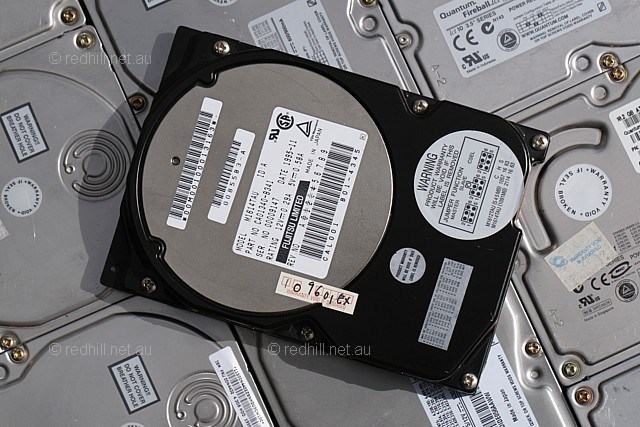
Photo: Red Hill.
Fujitsu M1614
As typical an example as any of the various Fujitsu IDE drives we were to come to dislike intensely over the next few years.
Fujitsu drives of this era were instantly recognisable, even inside a sealed computer case, because of the soft, sweet sound they made — not unlike that of the old Kyocera KC-20. They were probably the quietest drives of any from this period.
The Fujitsus seemed to be reliable enough, and were probably quite cheap (we never sold any new), but they were horribly slow — fit for comparison only with the notorious Quantum Bigfoot.
This was why we soon came to hate that sweet little Fujitsu peeping sound. The moment a system came into the workshop and you heard it, you immediately knew that no matter what you did to the system — upgrade the RAM, swap the CPU, wipe the operating system and reinstall from scratch — short of actually replacing the hard drive it would remain obstinately sluggish and unpleasant to use.
In an earlier entry I mentioned that nearly all Western Digital drives of this era were faster in real life than the specs would indicate. The corresponding Fujitsu drives, from this one on to around about the 6GB or 10GB period, were the opposite. Thankfully, they didn't have terribly good distribution in Australia so they were not all that common.
Adding insult to injury was one of those trivial matters that gets right under your skin. The model numbering, of these and of almost all the later Fujitsu drives, made no sense whatever. Without looking the model numbers up, how the devil were you supposed to be able to work out that an M1614TAU was a 1.09GB drive but the MPF3102AT was a 10GB unit? They did at least mark drives with a manufacturing date, something that not enough of the other makers did. This one left the factory in Japan during November 1995.
| Performance | 0.83 | Reliability | AAX |
| Claimed data rate | 63 Mbit/sec | Spin rate | 4500 RPM |
| Seek time | 12ms | Buffer | 64k |
| Platter capacity | 540MB | Encoding | PRML |
| Form | 3½ half height | Interface | IDE mode 4 |
| M1612TAU | 545MBGB | 2 TF heads | |
| M1614TAU | 1.09GB | 4 TF heads |